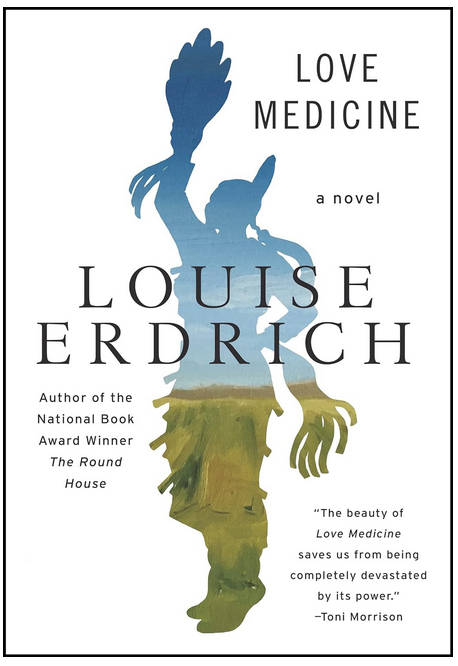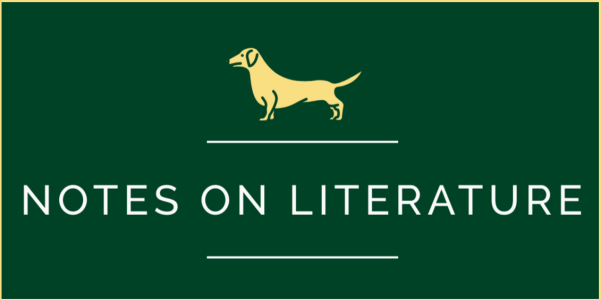
Love Medicine (2009) is a novel by author Louise Erdrich, depicting events taking place in the lives of various tribe members from the Ojibwe tribe, living in a fictious reservation in North Dakota, United States. In this novel, the reader is presented with topics relating to feminism, the rift between ‘whites’ and Native Americans as well as identity and belonging. This essay will briefly discuss elements of human-centered, or anthropogenic nature writing and deep ecology, or eco-philosophical nature writing in the novel. These ideas will be contrasted with the books Beginning Theory (2017), by Peter Barry and Critical Theory Today by Lois Tyson (2023).
According to Cheryl Glotfelty, ecocriticism is ‘the study of the relationship between literature and the physical environment’ (Glotfelty qtd in Barry 248), and one of the central concepts in ecocriticism is, according to Peter Barry, that nature is ‘an entity which affects us, and which we can affect’ (Barry 252). In Beginning Theory, Barry points out that an ecocritical reading of a text does not necessarily follow ‘a universally accepted model which we have merely to learn and follow’ (Barry 258). Instead, Barry suggests that an ecocritical reading of a literary text can take many forms, for example analysing and paying close attention to the ‘anthropogenic’ aspects in the text. Barry defines ‘the anthropogenic’ view regarding nature as a notion whereby ‘the wilderness is a space which is entered by those who would find themselves’ (Barry 257). According to this view, natural surroundings can be said to ‘perform a special function for us, a function [which] is vital to our well-being’ (Barry 257). Barry suggests that this type of ‘anthropogenic’, or human-centered nature writing is represented in particular in the American ‘transcendentalist’ writing, such as in the works of Ralph Waldo Emerson and Henry David Thoreau (Barry 249). In Thoreau’s Walden, the protagonist of the story goes ‘off-grid’ and leaves the modern world behind, in order to ‘return to nature’, and in Thoreau’ novel, the nature has a simple, ‘performative’ role (Barry 250). In contrast, the ‘deep ecology’ view suggests that ‘the planet can be saved by responsible…consumption and production’ and the view promotes ‘get[ting] back to the nature’ in order to secure a sustainable future for the mankind (Barry 257n5). In Critical Theory Today, Lois Tyson defines the concept of deep ecology as an ‘approach, to natural environment…that emphasizes harmony with, and protection of, the natural world’ (Tyson 413) The term deep ecology was devised by Arne Naess, and it includes eight points which Naess believes are ‘fundamental to what he calls eco-philosophy’ (Tyson 414). This essay will analyse Louise Erdrich’s novel Love Medicine, and attempts to identify which elements from the anthropogenic, and Naess’s deep ecology viewpoints are present in the text.
In the novel Love Medicine, the character of Eli is used as a symbol of an individual whose actions contribute to ‘ensur[ing] that the planet will remain hospitable’, as suggested by Naess. By taking these actions, the novel also suggests that humans are able to obtain a good quality of life. According to Naess, the quality of life ‘does not depend on accumulation of material wealth, such as acquiring…homes, furnishings, vehicles…and the like’ (Naess qtd in Tyson 416). Instead, Naess argues that the quality of life is to be found in ‘breathing cleaner air’, drinking clean water, and ‘knowing our children will inherit a healthy planet’ (Naess qtd in Tyson 416). In the novel, Eli’s brother Nector was sent to the government school to obtain a proper education, whilst Eli remained at home, in the reservation and spent much of his time and life running around in the adjoining woods. Albertine notes how ‘now, many years later, hard to tell why or how, my great uncle Eli was still sharp’ (Erdrich 18). Eli, one of the tribe’s elders taught the children to ‘carve, how to listen to the proper bird call’ (Erdrich 91), and Marie observed how ‘the woods were in Eli’ (Erdrich 86). However, Eli’s brother Nector, an educated and respected businessman with a nice house and a seemingly high status in the community, has dementia, and Albertine remarks how his ‘thoughts were hidden under rocks, disappearing in weeds’ (Erdrich 18). In the novel, Erdrich highlights, through the character of old Eli, the view that nature has the ability to ‘contribute to our well-being’ (Barry 257n5), and perhaps even more so than material goods and possessions ever will, providing support for Naess argument that the quality of life resides in pleasures derived from the nature. One could thus argue that the character of Eli symbolises the ability to obtain a good quality of life, by abandoning materialism and interacting in harmony with nature.
In the novel Love Medicine, the concept of sustainable consumption and production is explored in several passages, and the novel suggests that by contributing to upholding a variety of life forms, humans may secure the future ‘well-being of both human and non-human life forms’ as proposed by Naess (Naess qtd in Tyson 413). According to Naess, the ‘survival of human and non-human life’ is dependent on maintaining a rich biodiversity (Naess qtd in Tyson 414). In order to obtain a rich biodiversity, Naess suggests that ‘wilderness should be preserved from industrial and commercial development’ (Naess qtd in Tyson 414). This sustainable mind-set, whereby humans avoid industrial scale farming, production and consumption is evident in Erdrich’s novel. In the beginning of the novel, Zelda says: ‘She’s not used to buying this much meat. Remember how we used to trade for it?’, to which Aurelia replies ‘Or slaughtered our own’ (Erdrich 20). This exchange signifies the tribe’s strive for a sustainable way of living, and how this mind-set has been deeply ingrained in their everyday lives. Later on, Erdrich’s narrator observes how the children in the reservation shoot mud hens to bring home to roast (Erdrich 91), and how Marie sells locally produced cream and milk, and mends other peoples’ clothes in order to make a little bit of extra money (Erdrich 96), and how the tribe members ‘live off’ the piece of land that has been allotted to them. In the novel, Erdrich vividly depicts the sustainable way of living in the reservation and demonstrates how the Indian tribe members are engaged in both responsible consumption and production of natural resources: how they are living in harmony, with the nature. In doing so, Erdrich underscores the deep respect the tribe has for nature and how they contribute to the preservation and ‘survival of human and non-human life’, as described by Naess (Naess qtd in Tyson 414).
Lastly, in Erdrich’s novel, the author explores the concept of nature’s inherent value and demonstrates how nature has an intrinsic value on its own. Naess posits that human beings ‘cannot be understood as separate from the fabric of nature we are part of’ and that acknowledging the importance of ‘ecosphere’, consisting of ‘all living and non-living things’ is paramount (Naess qtd in Tyson 414). Erdrich illustrates this concept of being ‘one’ with nature through the character of Lulu. At the end of the novel, Lulu reminisces about her life and her questionable reputation as ‘a loose woman’, and states that ‘I was in love with the whole world and all that lived in its rainy arms…the green leaves would be blowing…I’d hear the wind rushing, rolling… I’d open my mouth wide, my ears wide, my heart, and I’d let everything inside (Erdrich 272). This utterance suggests that Lulu acknowledges her role as a child of nature: instead of being a man-eater, she was simply following her natural instincts, free from society’s norms and rules. By ‘opening’ her mouth and heart, she lets nature in, and becomes one with it. This notion of Lulu being intertwined with nature is supported further in her subsequent remark when she contemplates her own death: ‘As though death will set me free as a travelling cloud…I’ll be out there as a piece of the endless body of the world, feeling pleasures so much larger than skin, bones and blood’ (Erdrich 283). This suggests that Lulu recognises that, as Naess puts it, humans ‘cannot be understood as separate from the fabric of nature we are part of’ (Naess qtd in Tyson 414) and that nature itself has an intrinsic value, of its own.
In conclusion, Louise Erdrich’s novel Love Medicine explores the concept of deep ecology and rejects the anthropogenic view of nature. Erdrich’s novel proposes that abandoning materialism and interacting in harmony with nature can ensure a good quality of life; that engaging in sustainable farming, production and consumption will secure and preserve human and non-human life, and that nature has an intrinsic value on its own and we humans are intrinsically intertwined with nature. Lastly, one could argue that by rejecting the human-centered, anthropogenic nature writing style, Erdrich challenges the tradition of American transcendentalist writing, where nature is seen to have a ‘performative’ function. Instead, she calls for a new mode of nature writing, which underscores the importance of living in harmony with nature.
Works Cited
Barry, Peter. Beginning Theory. 4th ed., Manchester University Press, 2017.
Erdrich, Louise. Love Medicine: Newly Revised Edition. Harper Perennial, 2009.
Tyson, Lois. Critical Theory Today: A User-Friendly Guide. 4th ed., Routledge, 2023.
